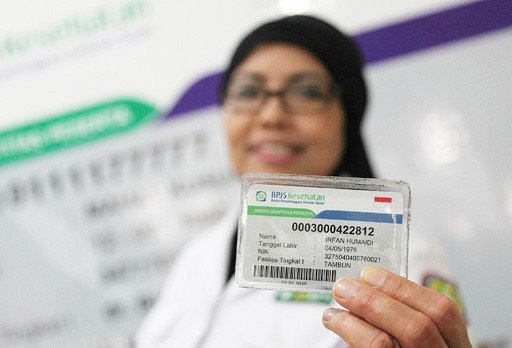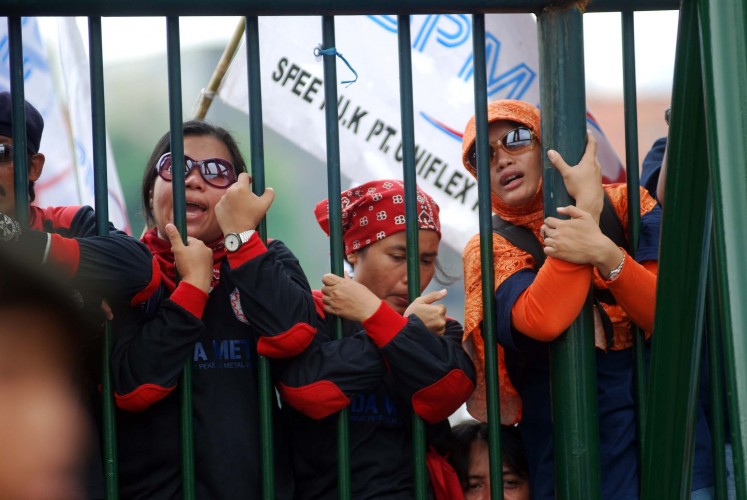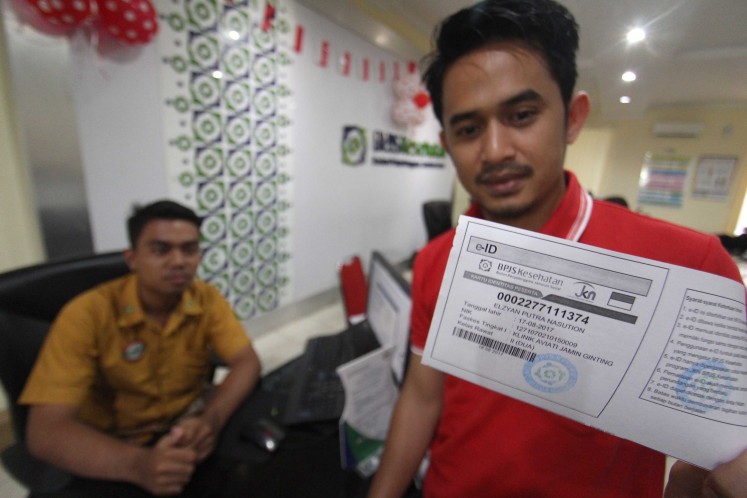Popular Reads
Top Results
Can't find what you're looking for?
View all search resultsPopular Reads
Top Results
Can't find what you're looking for?
View all search resultsQ&A: BPJS Kesehatan, health for all Indonesians
Change text size
Gift Premium Articles
to Anyone
U
niversal health coverage (UHC) remains a challenge for many countries worldwide and is thus the theme for World Health Day 2018. Achieving UHC is also one of the sustainable development goals (SDGs), which stipulates for good health and well-being. Currently, half of the world’s population lacks access to essential health services, according to the World Bank.
Indonesia’s health coverage program, the National Health Insurance (JKN) program, is administered by the BPJS Kesehatan (Healthcare and Social Security Agency). With a membership comprising 195.2 million people, the program is one of the biggest of its kind in the world. Furthermore, there is the Indonesian Health Card (KIS), an additional program that provides wider coverage and has been distributed to 92.4 million JKN holders.
Although the JKN is the health coverage program and BPJS is the agency, the term BPJS is loosely used to refer to the program.
Given its wide coverage, mostly among the lower middle class, BPJS has faced several hiccups in its operation. From continual deficits to discrimination faced by patients under the BPJS scheme, Indonesia still struggles to provide health care for all. The government has targeted that all Indonesians will have BPJS membership by 2019.
What is the state of the BPJS?
As of April 1, the number of JKN-KIS participants reached 195,170,283. Almost 60 percent of the members are recipients of a subsidy from the government.
Who pays for the BPJS?
Low-income members are subsidy beneficiaries whose premium is paid in full by the government. For privately employed workers, the premium is split by the employer and the employee. Independent workers and non-workers must pay the premium themselves.
Since its establishment in 2014, BPJS Kesehatan has suffered from serious deficits: Rp 3.3 trillion in 2014, Rp 6 trillion in 2015, Rp 9.7 trillion in 2016 and Rp 9 trillion in 2017. The deficit is mainly caused by trouble with collecting premium payments, both from the government and members.
For instance, the premium paid by the government for 92.4 million low-income participants is Rp 25,500 each. Independent workers pay RP 25,500 for third class facilities, Rp 51,000 for second class facilities and Rp 80,000 for first class facilities in hospitals. Meanwhile, people often neglect their responsibility to pay the premium, only paying when they need to use the health service.
The BPJS's deficit has always been covered by state funding, given that Law No. 24/2011 stipulates that the agency's income must come from insurance premiums and government assistance. The government has disbursed Rp 18.84 trillion between 2013 and 2016 to support the agency.
There has been talk of using the tobacco tax to support the BPJS. Finance Minister Sri Mulyani has expressed hope that regional administrations will put aside funds to help ease the BPJS’s deficit. BPJS Kesehatan president director Fahmi Idris mentioned another method in which to address the deficit, which was to cooperate with the Workers Social Security Agency (BPJS Ketenagakerjaan).
In the 2017 state budget, the government allocated Rp 106.7 trillion to health, the equivalent of 5 percent of the total state budget. In the regional provinces, as much as 10 percent of the total regional budget is allocated to health, or Rp 105.3 trillion out of Rp 1.05 quadrillion. However, these funds are prone to corruption due to poor supervision, according to a Corruption Eradication Commission study.
What is the history of the BPJS?
The BPJS largely owes its existence to the labor movement. Before the BPJS, workers were protected by Jamsostek, which was often criticized as it only covered workers in the private sector and only a small fraction at that. Civil servants and the military were protected under their own healthcare scheme, state-owned health insurance company Askes, while pensions for civil servants were covered by Taspen and military personnel were covered by Asabri.
Workers rally to demand for social security and universal health coverage in this photo taken in 2010. (JP/Wendra Ajistyatama)Following political reform after 1998, an idea to merge these agencies emerged, despite facing opposition. The bill was reportedly revised 56 times before a draft was submitted to the House of Representatives in January 2004. The existence of the BPJS is stipulated in Law No. 40/2004 law on national social security reform (SJSN).
Law No. 24/2011 on the BPJS, stipulates that BPJS Kesehatan should implement the health care insurance program from Jan. 1, 2014 and BPJS Ketenagakerjaan should implement the workers’ social security program from July 1, 2015.
In the years between the SJSN Law and the BPJS Law, it was the labor unions who kept the pressure on the government. The law on the BPJS was supposed to be passed on Dec. 30, 2010 but was delayed because of a rumor that the transformation of Jamsostek to BPJS would create a financial crisis. One prominent group who pushed the BPJS Law was the Action Committee for Social Security, a coalition of 66 labor unions, student associations and NGOs.
What sets the BPJS apart from other insurance programs?
The BPJS emphasizes a cross-subsidy system, where the rich help pay for the poor. In other insurance programs, every man is for himself.
Another difference is philosophical, as the BPJS aims at preventive health care rather than curative. Each member is assigned to a primary health care facility, which can be a community health center (Puskesmas) or family doctor. These facilities are expected to promote a healthy lifestyle to prevent sickness in the first place.
Where can patients get treatment under the scheme?
There are 26,938 health facilities where patients can get treatment under the BPJS. The number includes 9,863 community health centers (Puskesmas and private clinics), 2,139 hospitals, 1,194 dentists and 1,058 opticians.
According to Health Ministerial Regulation No. 28/2014 on the JKN, the insurance also covers emergency treatment at a health center that is not registered as a provider. However, many hospitals are not aware of this policy. Last year, a four-month-old baby died after a hospital refused to treat her because her parents could not pay the fees, despite the patient being a JKN member.
A father shows a copy of his infant son's universal health care card in this photo taken in August 2017. (Antara/-)Is the BPJS cooperating with private hospitals?
Yes, but private hospitals have a precarious relationship with the BPJS. From the registered 160 private hospitals in Jakarta, only 64 cooperate with the BPJS. There is no definitive data on the national scale.
Private hospitals are reluctant to join the BPJS scheme for mainly financial reasons. The claims for reimbursement might take months and the rates set by the government are sometimes below the hospital’s real operational cost, as reported by tempo.co. BPJS claims that the long process is because of a strict auditing procedure, as fraudulent claims were rife at the beginning of the program.
Another reason is the inadequate facilities. When joining the BPJS, a private hospital must cater to more patients and thus provide more facilities. A case in point is the temporary closure of RS Siloam in Kupang, East Nusa Tenggara for BPJS patients for three months. The hospital was asked to upgrade its facilities to cater to more low-income patients, as BPJS patients must pay more for VIP rooms because of the lack of first and second class rooms, as reported by Antara.
Has the BPJS cooperated with other insurance companies?
The BPJS has exchanged a coordination of benefits (COB) agreement with private-insurance associations. Under the COB scheme, the BPJS members who pay more for additional insurance coverage can enjoy more benefits otherwise not covered, including access to private hospitals that do not have a direct partnership with the BPJS.
Who supervises the BPJS?
Besides non-government watchdogs like BPJS Watch, BPJS Kesehatan provides several channels for public complaints, namely the BPJS Kesehatan Care Center on 1500400, the LAPOR! application on the BPJS Kesehatan website, branch offices, regency and town offices as well as BPJS Kesehatan officials stationed at health facilities.












